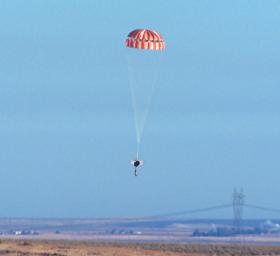
|
Testing Phoenix Mars Lander Parachute in Idaho
- Click the image above for a larger view
- Full-Res JPEG (691 x 631) (32.2 kB)
- Full-Res TIFF (691 x 631) (1.3 MB)
Caption:
NASA's Phoenix Mars Lander will parachute for nearly three minutes as it descends through the Martian atmosphere on May 25, 2008. Extensive preparations for that crucial period included this drop test near Boise, Idaho, in October 2006.
The parachute used for the Phoenix mission is similar to ones used by NASA's Viking landers in 1976. It is a "disk-gap-band" type of parachute, referring to two fabric components -- a central disk and a cylindrical band -- separated by a gap.
Although the Phoenix parachute has a smaller diameter (11.8 meters or 39 feet) than the parachute for the 2007 Mars Pathfinder landing (12.7 meters or 42 feet), its Viking configuration results in slightly larger drag area. The smaller physical size allows for a stronger system because, given the same mass and volume restrictions, a smaller parachute can be built using higher strength components. The Phoenix parachute is approximately 1.5 times stronger than Pathfinder's. Testing shows that it is nearly two times stronger than the maximum opening force expected during its use at Mars.
Engineers used a dart-like weight for the drop testing in Idaho. On the Phoenix spacecraft, the parachute is attached the the backshell. The backshell is the upper portion of a capsule around the lander during the flight from Earth to Mars and protects Phoenix during the initial portion of the descent through Mars' atmosphere.
Phoenix will deploy its parachute at about 12.6 kilometers (7.8 miles) in altitude and at a velocity of 1.7 times the speed of sound. A mortar on the spacecraft fires to deploy the parachute, propelling it away from the backshell into the supersonic flow. The mortar design for Phoenix is essentially the same as Pathfinder's. The parachute and mortar are collectively called the "parachute decelerator system." Pioneer Aerospace, South Windsor, Conn., produced this system for Phoenix. The same company provided the parachute decelerator systems for Pathfinder, Mars Polar Lander, Spirit, and Opportunity, ensuring that lessons learned from past programs were incorporated into the Phoenix system.
During the first 25 seconds of the three-minute period when Phoenix descends on its parachute, the spacecraft will cast away its heat shield and extend its three legs. About 43 seconds before reaching the surface of Mars, the lander will shed the parachute by separating from the backshell. The lander will begin firing its descent thrusters half a second after the separation from the backshell and continue using them until touchdown.
Background Info:
The Phoenix Mission is led by the University of Arizona, Tucson, on behalf of NASA. Project management of the mission is by NASA's Jet Propulsion Laboratory, Pasadena, Calif. Spacecraft development is by Lockheed Martin Space Systems, Denver.
Photojournal Note: As planned, the Phoenix lander, which landed May 25, 2008 23:53 UTC, ended communications in November 2008, about six months after landing, when its solar panels ceased operating in the dark Martian winter.
Cataloging Keywords:
| Name | Value | Additional Values |
|---|---|---|
| Target | Mars | |
| System | ||
| Target Type | Planet | |
| Mission | Phoenix | Mars Exploration Rover (MER), Mars Pathfinder (MPF), Viking |
| Instrument Host | Phoenix Lander | Opportunity (MER-B), Spirit (MER-A) |
| Host Type | Lander | Rover |
| Instrument | ||
| Detector | ||
| Extra Keywords | Atmosphere, Color | |
| Acquisition Date | ||
| Release Date | 2008-05-24 | |
| Date in Caption | 2008-05-25 | |
| Image Credit | NASA/JPL-Caltech | |
| Source | photojournal.jpl.nasa.gov/catalog/PIA10671 | |
| Identifier | PIA10671 | |
